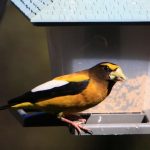The oldest division in the great avian tree lies between the ratites and tinamous (the paleognaths) and all other living birds (the neognaths). The neognaths, in turn, divide into the Galloanseres (waterfowl and galliform birds) and the Neoaves. Neoaves contains the great bulk of the diversity and the species of living birds, from songbirds to storks and owls to hummingbirds. That much we know.
But from there, determining relationships within Neoaves remains a very great challenge. Many of the historical orders within Neoaves (Accipitriformes, Gruiformes, Pelecaniformes, and Ciconiiformes, for instance) have been completely deconstructed in the last two decades. And long-vexing lineages, from doves and pigeons to the enigmatic Hoatzin, have continued to elude certain placement.
Why? The neoavian birds diversified rapidly a very long time ago, perhaps just after the K-T Boundary, the massive global extinction event that wiped out all non-avian dinosaurs and many other great lineages, including the pterosaurs. This makes reconstructing their relationships extraordinarily difficult, and perhaps in some cases impossible.
However, scientists have made leaps and bounds over the last decade or so as our ability to process and interpret genetic information has rapidly grown. The 2008 “Early Bird” framework proposed by Shannon Hackett and her colleagues is being ratified and refined by successive studies using new techniques and different sets of samples.
The latest of these, “A phylogeny of birds based on over 1,500 loci collected by target enrichment and high-throughput sequencing” by John E. McCormack et al., isn’t even officially published yet, but its authors made it available this month on a manuscript server called arXiv (a practice which, by the way, is still regarded with some uncertainty but appears to be gaining popularity).
The study affirms some relatively novel relationships considered controversial just a few years ago (e.g., the relationship between songbirds, parrots, and falcons) and proposes with some surprising new hypotheses of its own.
Tropicbird-Sunbittern relationship
Tropicbirds are highly aerial birds of remote islands and warm seas, mysterious for their habits as well as their relationships. Long classified with pelicans, cormorants, and frigatebirds because of their totipalmate feet (all four toes are webbed), they have recently been recognized as a distinct lineage of uncertain affinities. (See my post on the breakup of the “Pelecaniformes.”)

White-tailed Tropicbird (Phaethon lepturus) cc-by kansasphoto
Sunbitterns, meanwhile, are skulking, terrestrial denizens of the water’s edge in the Neotropics. Their recently discovered sister taxon is the New Caledonian Kagu, another ground-dwelling rainforest bird. It has been hypothesized that their common ancestor inhabited the ancient supercontinent Gondwana, of which both New Caledonia and South America are fragments. But how these two fantastical species were related to other neoavian birds had remained a mystery.

Sunbittern (Eurypyga helias) cc-by Tambako the Jaguar
Until now? McCormack et al. recovered a strongly supported close relationship between the Sunbittern and the tropicbirds! (Kagu wasn’t sampled in the study.) A result this unexpected and — on the surface — surprising will have to be explored in subsequent studies in order to gain wide acceptance.
Does such a relationship sound too strange to believe? Remember, the sister relationship between flamingos and grebes was only recently proposed and also seems quite difficult to believe; however, the hypothesis has since borne up under a wide range of genetic, morphological, and even behaviorial examinations and is now widely accepted. Within Neoaves, it seems, we should be expecting the unexpected.
Bustard-Turaco relationship
Another surprising new hypothesis emerging from the McCormack study is a close relationship between the terrestrial bustards and the arboreal turacos. Both groups have been difficult to place, but this particular arrangement has apparently never been proposed before. The authors do point out, however, that their study did not include any cuckoos, which have been placed with turacos in previous studies, and that perhaps the turacos, cuckoos, and bustards are all connected.

Kori Bustard (Ardeotis kori) cc-by Stig Nygaard

Livingstone’s Turaco (Tauraco livingstonii) cc-by Dean Croshere
Other findings … and what’s next
The full paper (PDF) is well worth perusual and will undoubtedly spur further discussion once it is formally published. The authors find support for the “waterbirds” and “landbirds” clades recovered in several recent studies and make some stabs at increasing resolution within those clades. The study also provides additional support for the relationship between songbirds, parrots, and falcons, which was recognized by the American Ornithologists’ Union just this year. But perennial head-scratchers like mousebirds, doves, and the Hoatzin continue to baffle.
So, while some parts of the neoavian tree are gradually emerging from obscurity, others remain puzzling. McCormack et al. suggest, however, that there is hope for increasing our understanding of these birds’ relationships as our ability to analyze and interpret genetic data grows. This paper should generate some interesting discussion, and another forthcoming paper, “The global diversity of birds in space and time,” to be published in Nature by W. Jetz, Thomas, G. H., Joy, J.B., Hartmann, K. and A.O. Mooers, also promises to be quite exciting.
Update (Feb. 20, 2013): A Phylogeny of Birds Based on Over 1,500 Loci Collected by Target Enrichment and High-Throughput Sequencing is now officially published on PLoS One.












Incredibly interesting…Bustard-Turaco and Tropicbird-Sunbittern are related …who what have thought it?